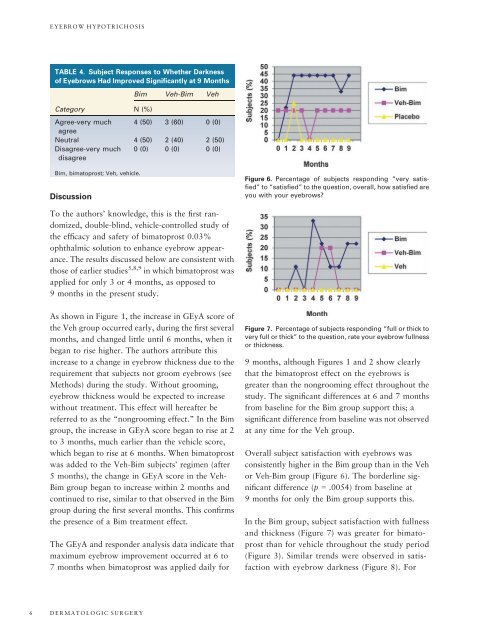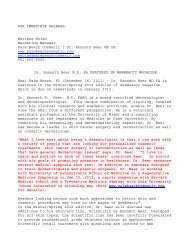Treatment of Eyebrow Hypotrichosis Using Bimatoprost - West Palm ...
Treatment of Eyebrow Hypotrichosis Using Bimatoprost - West Palm ...
Treatment of Eyebrow Hypotrichosis Using Bimatoprost - West Palm ...
You also want an ePaper? Increase the reach of your titles
YUMPU automatically turns print PDFs into web optimized ePapers that Google loves.
E YEBROW HYPOTRICHOSIS<br />
TABLE 4. Subject Responses to Whether Darkness<br />
<strong>of</strong> <strong>Eyebrow</strong>s Had Improved Significantly at 9 Months<br />
Bim Veh-Bim Veh<br />
Category<br />
N (%)<br />
Agree-very much 4 (50) 3 (60) 0 (0)<br />
agree<br />
Neutral 4 (50) 2 (40) 2 (50)<br />
Disagree-very much 0 (0) 0 (0) 0 (0)<br />
disagree<br />
Bim, bimatoprost; Veh, vehicle.<br />
Discussion<br />
Figure 6. Percentage <strong>of</strong> subjects responding “very satisfied”<br />
to “satisfied” to the question, overall, how satisfied are<br />
you with your eyebrows?<br />
To the authors’ knowledge, this is the first randomized,<br />
double-blind, vehicle-controlled study <strong>of</strong><br />
the efficacy and safety <strong>of</strong> bimatoprost 0.03%<br />
ophthalmic solution to enhance eyebrow appearance.<br />
The results discussed below are consistent with<br />
those <strong>of</strong> earlier studies 5,8,9 in which bimatoprost was<br />
applied for only 3 or 4 months, as opposed to<br />
9 months in the present study.<br />
As shown in Figure 1, the increase in GEyA score <strong>of</strong><br />
the Veh group occurred early, during the first several<br />
months, and changed little until 6 months, when it<br />
began to rise higher. The authors attribute this<br />
increase to a change in eyebrow thickness due to the<br />
requirement that subjects not groom eyebrows (see<br />
Methods) during the study. Without grooming,<br />
eyebrow thickness would be expected to increase<br />
without treatment. This effect will hereafter be<br />
referred to as the “nongrooming effect.” In the Bim<br />
group, the increase in GEyA score began to rise at 2<br />
to 3 months, much earlier than the vehicle score,<br />
which began to rise at 6 months. When bimatoprost<br />
was added to the Veh-Bim subjects’ regimen (after<br />
5 months), the change in GEyA score in the Veh-<br />
Bim group began to increase within 2 months and<br />
continued to rise, similar to that observed in the Bim<br />
group during the first several months. This confirms<br />
the presence <strong>of</strong> a Bim treatment effect.<br />
The GEyA and responder analysis data indicate that<br />
maximum eyebrow improvement occurred at 6 to<br />
7 months when bimatoprost was applied daily for<br />
Figure 7. Percentage <strong>of</strong> subjects responding “full or thick to<br />
very full or thick” to the question, rate your eyebrow fullness<br />
or thickness.<br />
9 months, although Figures 1 and 2 show clearly<br />
that the bimatoprost effect on the eyebrows is<br />
greater than the nongrooming effect throughout the<br />
study. The significant differences at 6 and 7 months<br />
from baseline for the Bim group support this; a<br />
significant difference from baseline was not observed<br />
at any time for the Veh group.<br />
Overall subject satisfaction with eyebrows was<br />
consistently higher in the Bim group than in the Veh<br />
or Veh-Bim group (Figure 6). The borderline significant<br />
difference (p = .0054) from baseline at<br />
9 months for only the Bim group supports this.<br />
In the Bim group, subject satisfaction with fullness<br />
and thickness (Figure 7) was greater for bimatoprost<br />
than for vehicle throughout the study period<br />
(Figure 3). Similar trends were observed in satisfaction<br />
with eyebrow darkness (Figure 8). For<br />
6<br />
DERMATOLOGIC SURGERY





